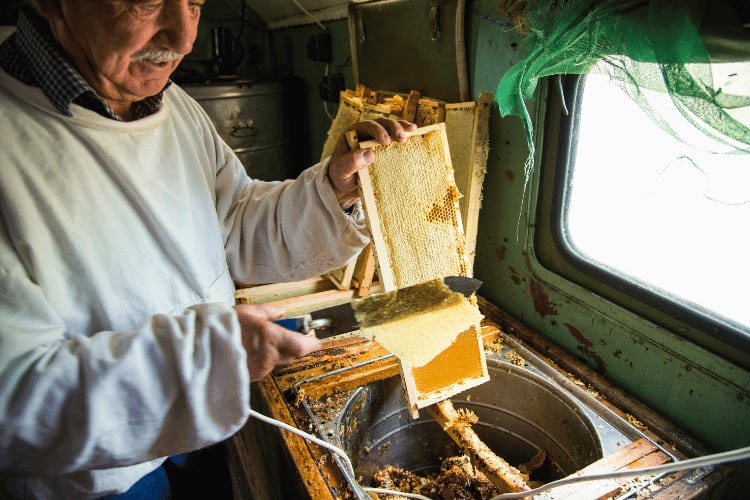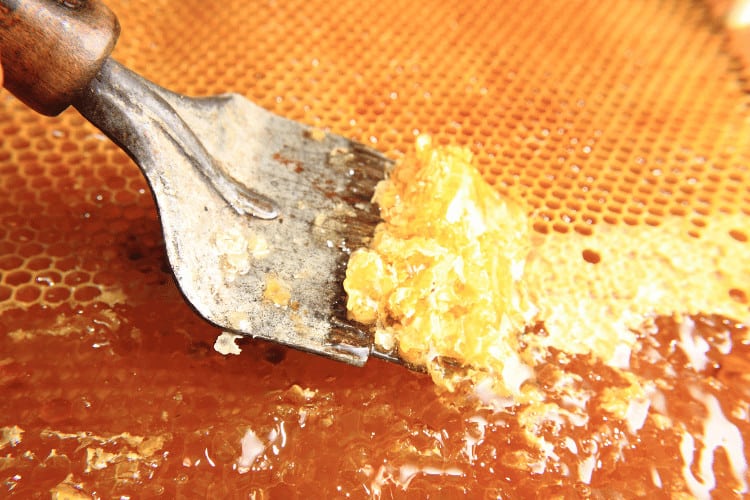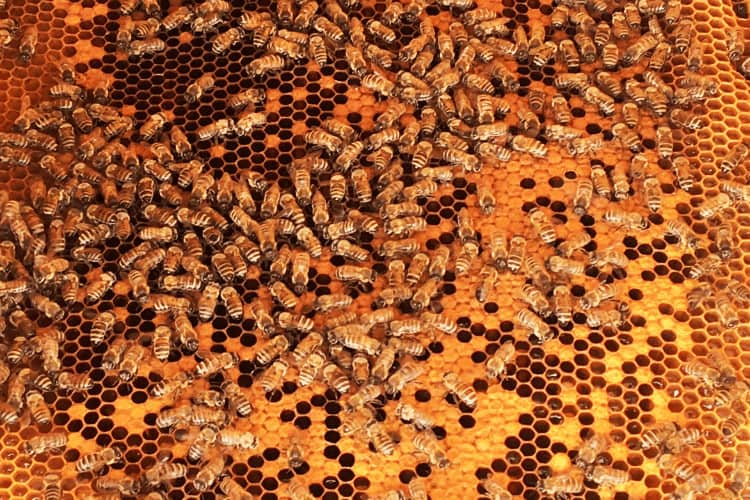How to Separate Honey from Wax Like a Pro
Honey is a delicious and nutritious food that is produced by bees. It’s made up of sugars, water, and other nutrients. Beeswax is the waxy substance that bees use to build their honeycombs. It’s made up of a mixture of esters, alcohols, and hydrocarbons.
Honey and beeswax are often separated from each other in order to sell the honey or to use the beeswax for other purposes. There are a number of different methods that you can use to separate honey from wax. One popular, simple method is the scrape and drain, which involves removing the honey cappings from the honeycombs while they’re still on the frames of honey. And then, scraping the honey out of the cells. The honey will then drain into a container.
In this article, we’ll discuss four of the most common methods for separating raw honey from wax. We’ll also provide some tips for separating honey from wax and discuss the pros and cons of each method.
Why Separate Honey From Wax?

There are a number of reasons why we separate honey and beeswax from each other.
To Sell the Honey
Honey is a delicious and nutritious food, but it’s also a perishable product. If you won’t separate honey from the wax, it can quickly spoil. By separating the honey from the wax, you can store it for longer periods of time and sell it to consumers.
Honey is typically sold in jars or bottles. The wax cappings that cover the honeycombs are removed before the honey is extracted. We do this because the wax cappings aren’t edible and they can make the honey taste bitter.
To Use the Beeswax for Other Purposes
Beeswax is a versatile material that can be used for a variety of purposes, such as making furniture polish, sealants, crafts, and cosmetics. By separating the beeswax from the honey, you can use it for these purposes and more.
You can also sell beeswax to other businesses that use it to make candles, lip balm, and other products. They can use the beeswax themselves to make these products or use them in other ways, such as for waterproofing.
To Improve the Quality of the Honey
When you separate honey from wax, it would be easier to filter and remove any impurities. This can improve the quality of the honey and make it more appealing to consumers.
The wax cappings can contain small particles of dirt or debris. These particles can make the honey look cloudy or unappealing. As soon as you separate the honey from the wax, these particles can be removed, which can improve the clarity and appearance of the honey.
The best method for separating honey from wax will depend on your specific needs. However, there are a number of different methods that can be used, such as:
- Centrifugal extractors
- Scrape and drain methods
- Crush and strain methods
- Boiling methods.
The Best Methods for Separating Honey From Wax
The best method for you will depend on your specific needs and preferences.
If you’re looking for a simple and inexpensive method, then the scrape and drain method or the crush and strain method may be a good option for you.
On the other hand, if you’re looking for a more efficient method, then the centrifugal extractor or the boiling method may be a better option.
Centrifugal Extractor
Centrifugal extractors are the most common method for separating honey from wax. These machines spin the honey and wax mixture at a high speed, which causes the honey to separate from the wax. The honey is then collected in a separate container.
Over the years, we’ve found that centrifugal extractors are relatively easy to use. Simply place the honeycombs in the honey extractor and turn it on. The honey will be separated from the wax and collected in a container.
Centrifugal extractors are the most efficient way to separate honey from wax. They can separate honey from wax quickly and easily while keeping the honey frames intact. However, you might find them a bit on the expensive side.
Scrape and Drain Method
After trying many separation techniques, we can safely say that the scrape and drain method is a super simple and inexpensive way to separate capped honey from the wax.
This method involves removing the honey cappings from the honeycombs while they’re still on the frames of honey. And then, scraping the honey out of the cells. The honey will then drain into a container.
To use the scrape and drain method, you’ll need a sharp knife or a spoon to remove the honey cappings. You’ll also need a container to catch the honey.

Once the honey cappings have been removed, you can scrape the honey out of the cells. You can use a spoon or your fingers to do this. The honey will then drain into the container.
The scrape and drain method is a simple and inexpensive way to separate honey from wax. However, it can be time-consuming and it can be difficult to get all of the honey out of the cells.
Crush and Strain Method
The crush and strain method is another simple way to separate honey from the wax. In this method, we crush the honeycombs and then strain the honey out of the mixture.
To use the crush and strain method, you’ll need a food processor or a blender to crush the honeycombs. You’ll also need a strainer to strain the honey.
Once the honeycombs have been crushed, you can strain the honey out of the mixture. You can use a cheesecloth or a fine mesh strainer to do this.
The crush and strain method is a simple and inexpensive way to separate honey from wax. However, it can be messy and it can be difficult to get all of the honey out of the mixture.
Boiling Method
The boiling method is a more efficient way to separate honey from wax than the scrape and drain method or the crush and strain method.
Here we boil the honeycombs, let the indirect heat melt the wax, and watch the honey as it floats to the top. Then, we skim the honey off of the top of the hot water.
To use the boiling method, you will need a pot, water, and honeycombs.
Fill the pot with water and bring it to a boil. Add the honeycombs to the boiling water and let them cook for about 10 minutes. The wax will melt and the honey will float to the top.
Once the wax has melted, you can skim the honey off of the top of the water. You can use a spoon or a strainer to do this.
The boiling method is a more efficient way to separate honey from wax than the scrape and drain method or the crush and strain method. However, it can also be more dangerous. The wax can catch fire if it isn’t boiled properly.
Tips for Separating Honey From Wax
- Use a clean, dry container. This will help to prevent the honey from becoming contaminated. If the container is dirty, it could introduce bacteria or other contaminants into the honey, which could spoil it. The container should also be dry to prevent the honey from becoming watery.
- Be careful not to heat the honey too much. This can destroy the nutrients in the honey. The honey should be heated to a temperature of no more than 140 degrees Fahrenheit. Higher temperatures can cause the honey to lose its nutrients and flavor.
- Strain the honey to remove any impurities. This will help to improve the clarity and taste of the honey. The honey can be strained through a piece of cheesecloth or a fine mesh strainer. This will remove any small wax particles or other impurities from the honey.
- Store the honey in a cool, dark place. This will help to preserve the honey and prevent it from spoiling. The honey should be stored in a cool, dark place like a pantry or cupboard. This will help to prevent the honey from becoming oxidized or contaminated.
What Is the Easiest Method to Separate Beeswax From Honey?

The easiest separation method for honey from wax is the scrape and drain method. This method is simple and does not require any special equipment. However, it can be time-consuming and it’s sometimes difficult to get every bit of honey out of the cells.
Here are some tips for using the scrape and drain method:
- Use a sharp hot knife or spoon to remove the honey cappings. This will help to prevent the honey from dripping down the sides of the honeycombs.
- Be careful not to damage the honeycombs. If the honeycombs are damaged, the honey will be more difficult to remove.
- Use a clean, dry container to catch the honey. This will help to prevent the honey from becoming contaminated.
If you’re only separating a small amount of honey, the scrape and drain method may be the best option for you. It’s a simple and easy way to separate honey from wax.
Conclusion
Honey is a delicious and nutritious food that is produced by bees. However, before honey can be enjoyed, it must be separated from the wax that it is contained in.
There are a number of different methods that you can use to separate beeswax from honey, each with its own advantages and disadvantages.
In this article, we’ve discussed some tips and tricks for separating honey from wax. We’ve also provided an overview of the different methods that can be used. Now, you can choose the best method for your needs.
By following the tips in this article, you can successfully separate honey from wax and enjoy the delicious and nutritious benefits of this natural food.
